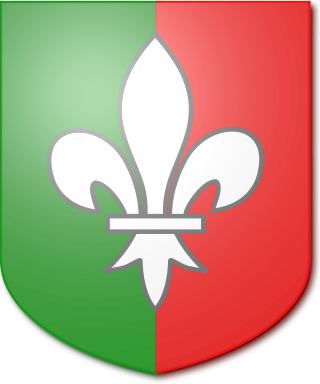
Viscount Hardinge, of Lahore and of Kings Newton in the County of Derby, is a title in the Peerage of the United Kingdom. It was created in 1846 for the soldier and Tory politician Sir Henry Hardinge. His son, the second Viscount, represented Downpatrick in Parliament. His great-great-grandson, the sixth Viscount, succeeded a distant relative as eighth Baronet, of Belle Isle in the County of Fermanagh, in 1986. This title had been created in the Baronetage of the United Kingdom 1801 for Richard Hardinge. He was the third son of Nicolas Hardinge, younger brother of Reverend Henry Hardinge and uncle of the latter's third son Henry Hardinge, 1st Viscount Hardinge. The baronetcy was created with special remainder to the heirs male of Richard Hardinge's father.

The Antrobus Baronetcy, of Antrobus in the County Palatine of Chester, is a title in the Baronetage of the United Kingdom.
The Adair Baronetcy, of Flixton Hall in the County of Suffolk, was a title in the Baronetage of the United Kingdom. It was created on 2 August 1838 for Robert Adair. He was succeeded by his eldest son, the second Baronet. He sat as Member of Parliament for Cambridge. In 1873 he was created Baron Waveney, of South Elmham in the County of Suffolk, in the Peerage of the United Kingdom. The barony became extinct on his death in 1886 while he was succeeded in the baronetcy by his younger brother, Hugh Adair, the third Baronet. The latter had earlier represented Ipswich in Parliament. Two of his sons, the fourth and fifth Baronets, both succeeded in the title. The fifth Baronet's son, the sixth Baronet, was a major general in the British Army. The title became extinct on the latter's death in 1988.

There has been one creation of a baronetcy with the surname Dering.

The Wiggin Baronetcy, of Metchley Grange in Harborne in the County of Stafford and of Garth Gwynion in Machynlleth in the County of Montgomery, is a title in the Baronetage of the United Kingdom. It was created on 17 June 1892 for Henry Wiggin. He was the founder of Henry Wiggin and Co Ltd, manufacturers of specialty metal products, and also represented Staffordshire East and Handsworth in the House of Commons. The second Baronet was High Sheriff of Staffordshire in 1896. The third Baronet was a colonel in the army and served as High Sheriff of Warwickshire in 1942. The fourth Baronet was high sheriff of Warwickshire from 1975 to 1976 and a deputy lieutenant of the county in 1985.

The Synge Baronetcy, of Kiltrough in the County of Meath, is a title in the Baronetage of the United Kingdom. It was created on 12 August 1801 for Robert Synge. The third Baronet served as High Sheriff of County Cork in 1844. The family surname is pronounced "Sing". As of 28 February 2014 the present Baronet has not successfully proven his succession and is therefore not on the Official Roll of the Baronetage, with the baronetcy considered dormant since 2011.

The Medlycott Baronetcy, of Ven House in the County of Somerset, was a title in the Baronetage of the United Kingdom. It was created on 3 October 1808 for William Medlycott, Member of Parliament for Milborne Port from 1790 to 1791. The family descended from James Medlycott, of Ven House, who represented Milborne Port in the House of Commons between 1710 and 1722. His son Thomas Medlycott died without surviving male issue in 1763 and left his estates to his maternal nephew Thomas Hutchings, who adopted the surname of Medlycott. His son was the first Baronet. The baronetcy became extinct with the death of the 9th Baronet in 2021.
The Floyd Baronetcy is a title in the Baronetage of the United Kingdom. It was created on 30 March 1816 for General John Floyd. He was second-in-command at the Battle of Seringapatam in 1799. Floyd's daughter Julia was the wife of Prime Minister Sir Robert Peel, 2nd Baronet. The fifth Baronet was a Brigadier in the 15th/19th Hussars and was Chief-of-Staff of the Eighth Army from 1944 to 1945. Between 1961 and 1968 he served as Lord-Lieutenant of Buckinghamshire. The seventh Baronet was High Sheriff of Rutland in 1968. The fourth baronet's youngest son, Charles Murray Floyd, was a prominent businessman, surveyor and land agent.
The Lacon Baronetcy, of Great Yarmouth in the County of Norfolk, is a title in the Baronetage of the United Kingdom. It was created on 11 December 1818 for Edmund Lacon. The second Baronet was High Sheriff of Norfolk. The third Baronet sat as Conservative Member of Parliament for Great Yarmouth and Norfolk North. The family seat has been Ormesby House in Ormesby St Michael.

The ffolkes Baronetcy, of Hillington in the County of Norfolk, is a title in the Baronetage of Great Britain. It was created on 26 May 1774 for Martin ffolkes, FRS later High Sheriff of Norfolk and Member of Parliament for King's Lynn. The second Baronet represented Norfolk and Norfolk West in the House of Commons while the third Baronet represented King's Lynn. The fifth Baronet was Honorary Chaplain to Queen Victoria, Chaplain-in-Ordinary to Edward VII and George V and Chaplain to Edward VIII and George VI.

The Rycroft Baronetcy, of Calton in the County of York, is a title in the Baronetage of Great Britain. It was created on 22 January 1784 for Reverend Richard Rycroft. Born Richard Nelson, he was the only surviving son of John Nelson, and had assumed by Royal sign-manual the surname of Rycroft in lieu of his patronymic in 1758. The fifth Baronet was high sheriff of Hampshire in 1899. The sixth Baronet was high sheriff of Hampshire in 1938.

The Elton Baronetcy, of Bristol, is a title in the Baronetage of Great Britain. It was created on 31 October 1717 for Abraham Elton, Mayor of and Member of Parliament for Bristol from 1722 to 1727. The second Baronet was also Mayor of Bristol and represented Taunton and Bristol (1727–1742) in the House of Commons. The seventh Baronet sat as Liberal Member of Parliament for Bath. The eighth Baronet was High Sheriff of Somerset in 1895. The tenth Baronet was a pioneer of the British documentary film industry.

The Buckworth, later Buckworth-Herne, later Buckworth-Herne-Soame Baronetcy, of Sheen in the County of Surrey, is a title in the Baronetage of England. It was created on 1 April 1697 for John Buckworth, High Sheriff of London in 1704. The second Baronet sat as Member of Parliament for Weobley. The third Baronet was Assistant Gentleman Usher to George II. The fifth Baronet was Gentleman-Pensioner and Exon of the Guard during the reign of George III. He married Anne, daughter of Paston Herne, of Haveringland Hall, Norfolk, and assumed by Royal licence the additional surname of Herne. The sixth Baronet assumed in 1806 by Royal licence the additional surname of Soame in compliance with the will of Sir Peter Soame, 4th Baronet, of Thurlow. The ninth Baronet was a member of the Shropshire County Council.

The Boynton baronetcy, of Barmston in the County of York, was a title in the Baronetage of England. It was created on 15 May 1618 for Matthew Boynton, son of Sir Francis Boynton of Barmston Hall, in the East Riding of Yorkshire. The Boyntons came to Barmston following the marriage of heiress Margaret de la See to Sir Henry Barmston in the 15th century. The first Baronet married Francis Griffith, heiress of an estate at Burton Agnes including Burton Agnes Hall and Burton Agnes Manor House which the second Baronet inherited in 1647. The fifth and sixth Baronets both served as High Sheriff of Yorkshire, in 1750 and 1771 respectively. The eleventh Baronet died without male issue and the Baronetcy passed to his cousin. His estates however passed to his daughter Cicely whose husband Thomas Lamplugh Wickham changed his name on marriage to Wickham-Boynton, and later (1989) to Cunliffe-Lister relations descended from Mary Constance Boynton, wife of the 1st Earl of Swinton. The title became extinct on the death of the thirteenth Baronet in 1966.

The Filmer Baronetcy, of East Sutton in the County of Kent, was a title in the Baronetage of England. It was created on 26 December 1674 for Robert Filmer, of East Sutton Place, East Sutton, Kent. He was the grandson of Sir Edward Filmer, of Little Charleton, High Sheriff of Kent in 1616, who married Elizabeth Argall of East Sutton and purchased the estate there from her brother. His son Sir Robert Filmer, father of the first Baronet, was a supporter of the Crown during the English Civil War. The baronetcy was created for his son, also Robert Filmer, after the Restoration of Charles II in his honour.

The Palmer Baronetcy, of Carlton in the County of Northampton, was created in the Baronetage of England on 7 June 1660 for the lawyer and politician Geoffrey Palmer. The second Baronet was Member of Parliament for Higham Ferrers. The third, fourth and fifth Baronets all represented Leicestershire in the House of Commons. The fifth Baronet served as High Sheriff of Leicestershire in 1782 and the eighth Baronet as High Sheriff of Northamptonshire in 1871.

The Hudson, later Palmer Baronetcy, of Wanlip Hall in the County of Leicester, was created in the Baronetage of Great Britain on 28 July 1791 for Charles Grave Hudson, a Director of the South Sea Company and High Sheriff of Leicestershire in 1784. In 1813 the second Baronet assumed by royal sign-manual the surname of Palmer in lieu of his patronymic on succeeding to the estates of his maternal grandfather, Henry Palmer, of Wanlip. The title vests in its ninth holder.

The Lees Baronetcy, of Blackrock in the County of Dublin, was created in the Baronetage of the United Kingdom on 30 June 1804 for the soldier and politician John Lees.
The Preston baronetcy, of Beeston St Lawrence in the County of Norfolk, was created in the Baronetage of the United Kingdom on 30 May 1815 for Thomas Hulton Preston. Born Thomas Hulton, he was the son of Henry Hulton and his wife Elizabeth, daughter of Isaac Preston of Beeston St Lawrence, whose estates he inherited. In 1804 he assumed the surname of Preston in lieu of his patronymic. He was a militia colonel in the Norfolk volunteer infantry.

The Hare baronetcy, of Stow Hall in the County of Norfolk, was created in the Baronetage of the United Kingdom on 14 December 1818 for Thomas Hare, a soldier of the American Revolutionary War; he was the grandson of Thomas Leigh, husband of Mary, second daughter of the 2nd Baronet of the 1641 creation, and sister and co-heiress of the 5th Baronet of that creation. Born Thomas Leigh, he assumed by Act of Parliament the surname of Hare in lieu of his patronymic in 1791.
















